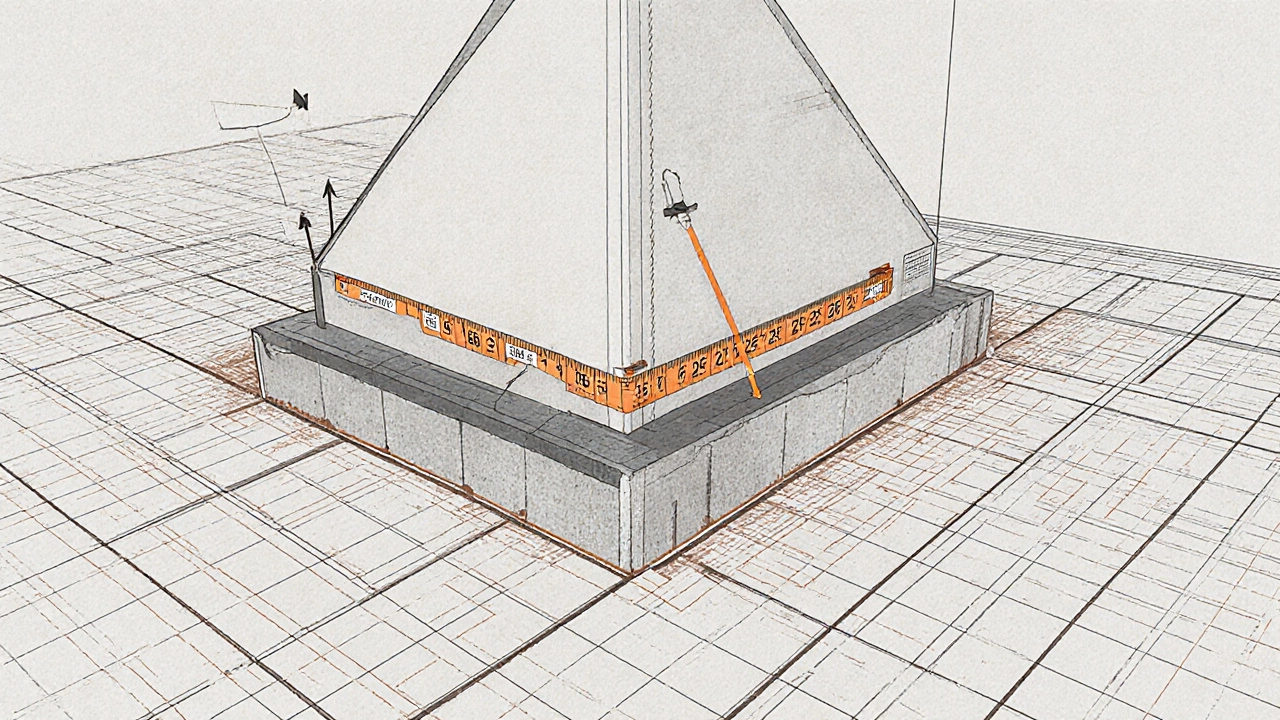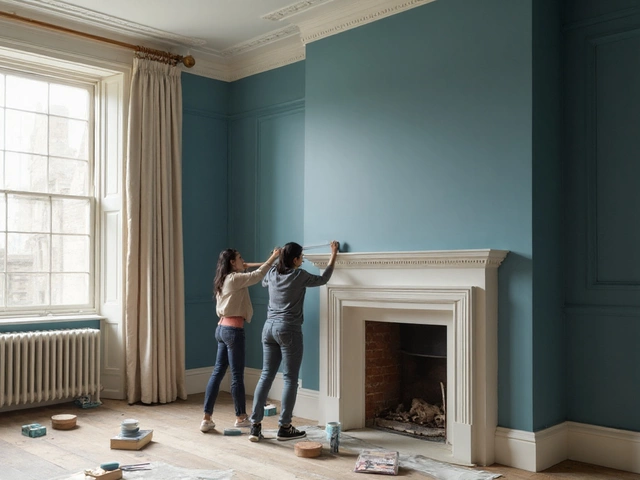
3-4-5 Method Calculator
Verify Your Right Angle
The 3-4-5 method ensures perfect 90-degree corners. Enter your measured side lengths and verify if your layout is square.
How to use
1. Measure one side from corner point (3-units)
2. Measure perpendicular side from same corner (4-units)
3. Measure diagonal between the two marks
4. If diagonal equals 5-units, you have a perfect right angle
When you’re laying out a foundation, framing a wall, or setting up a grid for a commercial building, getting things square isn’t optional. A few degrees off can mean misaligned doors, crooked windows, or worse - structural issues down the line. That’s where the 3-4-5 method comes in. It’s not fancy. It doesn’t need a laser level or a digital calculator. All you need is a tape measure, a pencil, and basic math anyone can do in their head.
How the 3-4-5 Method Works
The 3-4-5 method is based on the Pythagorean theorem: in a right triangle, a² + b² = c². If one side is 3 units, another is 4 units, the hypotenuse (the diagonal) must be 5 units to form a perfect 90-degree angle. That’s it. You don’t need to know what Pythagoras did in ancient Greece. You just need to remember 3, 4, 5.
Builders use this trick every day because it’s reliable. No batteries. No calibration. No software glitches. You stretch a tape measure 3 feet along one edge, mark it. Then go 4 feet perpendicular from that point. If the diagonal between those two marks is exactly 5 feet, you’ve got a perfect corner. If it’s less than 5, the angle is too sharp. If it’s more than 5, the angle is too wide. Adjust until it hits 5, and you’re square.
Why It’s Still Used in Modern Construction
You might think with all the tech we have - GPS-guided lasers, robotic total stations, digital levels - the 3-4-5 method is outdated. But in the field, it’s still the first tool many crews reach for. Why? Because it’s fast, cheap, and works when the tech fails.
Imagine you’re on a job site in Auckland. It’s raining. The laser level’s battery died. The ground is muddy. You need to lay out the corners of a warehouse foundation before the concrete truck arrives. You grab a 100-foot tape, mark 30 feet on one side, 40 feet on the other, and check the diagonal. If it’s 50 feet? You’re square. No fuss. No waiting. No excuses.
Even large commercial contractors use scaled-up versions: 6-8-10, 9-12-15, or even 12-16-20. The ratio stays the same. The math doesn’t change. You’re not measuring inches - you’re measuring confidence.
How to Use the 3-4-5 Method Step by Step
Here’s how to apply it on a real project:
- Start at your corner point. Drive a stake or mark the exact location.
- From that point, measure 3 units (feet, meters, yards - doesn’t matter as long as you’re consistent) along one direction. Mark it clearly.
- From the same starting point, measure 4 units in a perpendicular direction. Mark that point too.
- Measure the distance between the two marks. If it’s exactly 5 units, your angle is 90 degrees.
- If it’s not 5, adjust the second line slightly until the diagonal hits 5. Lock it in with another stake or chalk line.
You can repeat this for every corner of the building. It’s not just for foundations. Use it to square up wall frames, align tile layouts, or even check if a deck is level and square before you start nailing.

Common Mistakes People Make
Even with something this simple, mistakes happen. Here are the top three:
- Using inconsistent units. Mixing feet and meters? That breaks the ratio. Stick to one unit throughout.
- Not measuring from the same starting point. The 3 and 4 must both start from the corner. If you measure 3 from point A and 4 from point B, you’re not testing the angle - you’re just measuring random distances.
- Ignoring tension on the tape. A loose tape gives false readings. Pull it taut. If you’re measuring 40 feet, make sure it’s not sagging in the middle.
One contractor I worked with in Wellington swore by the 3-4-5 method - until he used a 30-foot tape to lay out a 100-foot wall and didn’t realize the tape had stretched from wear. The whole wall came out 2 inches off. He learned: always check your tools. A worn tape can be off by half an inch over 30 feet. That’s enough to ruin a grid.
When Not to Rely on the 3-4-5 Method
It’s powerful, but it’s not magic. There are limits.
For small projects - like hanging a cabinet or laying a few tiles - it’s perfect. For large-scale commercial buildings, you’ll still need surveying equipment for overall alignment, elevation control, and long-distance accuracy. The 3-4-5 method is for local angles, not global positioning.
Also, if you’re working on uneven ground, or the surface isn’t flat, the method can give misleading results. The triangle has to lie flat. If one point is 6 inches higher than the other, your 5-foot diagonal won’t be accurate. In those cases, use a spirit level or laser to establish a level plane first, then apply the 3-4-5 rule.
Scaling Up: Beyond 3-4-5
You don’t have to stick to 3, 4, and 5. Any multiple works:
- 6-8-10
- 9-12-15
- 12-16-20
- 15-20-25
Why use bigger numbers? Because they reduce error. If you’re off by half an inch on a 3-foot measurement, that’s a 17% error. On a 12-foot measurement, half an inch is only a 4% error. For large buildings, go big. Use 15-20-25 feet. It’s more accurate and easier to spot small deviations.
Some crews even use a pre-marked rope with knots at 3, 4, and 5 feet. They just stretch it out like a giant triangle. No tape needed. No math. Just pull and check.

Real-World Example: Laying Out a Retail Store
Last year, a client in Christchurch wanted to build a 60x40-foot retail space. The architect’s plans were precise, but the site had a slight slope. The crew started by marking one corner with a stake. They ran a chalk line 60 feet along the long side. Then, from that same corner, they measured 40 feet perpendicular.
Instead of using 3-4-5, they used 15-20-25. They measured 15 feet along the first line, 20 feet along the second, and checked the diagonal. It came out 25 feet and 1 inch. Too long. They nudged the second line inward by 2 inches. Checked again. Now it was 24 feet 11.5 inches. Close. One more tweak. Finally - 25 feet exactly.
They locked in that corner. Then repeated the process for every other corner. By the time the foundation crew arrived, the entire grid was square to within 1/8 of an inch. The drywall went up without a single misaligned stud. No callbacks. No rework. Just clean, efficient work.
Tools That Help - But Don’t Replace - the 3-4-5 Method
There are gadgets that claim to make squaring easier: digital angle finders, laser squares, smartphone apps. Some are great. But they’re backups, not replacements.
A laser square costs $200. A tape measure costs $15. The laser needs charging. The tape doesn’t. The laser can be blinded by sunlight. The tape works in rain, snow, or midnight. The 3-4-5 method doesn’t care about weather, battery life, or software updates. That’s why it’s still the backbone of field layout.
Smart crews use both. They use the laser to get close, then confirm with the 3-4-5 method. It’s like double-checking your work. One tool gives speed. The other gives certainty.
Final Thought: It’s Not About Math - It’s About Trust
The 3-4-5 method isn’t just a trick. It’s a tradition. It’s passed down from foreman to apprentice. It’s the reason a building stands true for 50 years. You don’t need to understand the math to use it. You just need to trust it.
And when you’re standing on a job site, watching a team lay out a 10,000-square-foot warehouse with nothing but a tape and a few stakes - and everything comes out perfectly square - you realize some of the best tools in construction aren’t high-tech. They’re just simple. And they’ve stood the test of time.
Can I use the 3-4-5 method with metric measurements?
Yes. The method works with any unit. Just use multiples of 3, 4, and 5. For example: 30 cm, 40 cm, 50 cm. Or 3 meters, 4 meters, 5 meters. The ratio stays the same. Metric is actually easier because it’s base-10. Many builders in New Zealand and Europe use 60-80-100 cm for small layouts and 3-4-5 meters for larger ones.
Do I need a partner to use the 3-4-5 method?
Not necessarily. You can do it alone by marking the first two points with stakes or chalk, then walking to the end of the tape to measure the diagonal. But it’s easier with two people - one holds the tape at the corner, the other holds it at the 3-foot and 4-foot marks. Two people reduce errors and speed things up.
Is the 3-4-5 method accurate enough for commercial buildings?
Yes, when used correctly. For layout and framing, it’s more than accurate enough. Most building codes allow a tolerance of ±1/4 inch over 10 feet. The 3-4-5 method can achieve ±1/8 inch with a good tape and careful technique. For overall site alignment or elevation, you’ll still need surveying equipment - but for individual corners and walls, this method is industry standard.
Why not just use a carpenter’s square?
Carpenter’s squares are great for small projects - like framing a wall or cutting trim. But they’re too short for laying out foundations or large grids. A 24-inch square can’t check a 20-foot wall. The 3-4-5 method scales to any size. It’s the only reliable way to square up something bigger than your arm.
What if my tape measure isn’t accurate?
Always check your tape. A 25-foot tape that’s worn or stretched can be off by half an inch. Test it against a known standard - like a new tape or a calibrated ruler. If it’s off, replace it. A bad tape gives you a false square. That’s how crooked buildings happen. Never trust a tape you haven’t verified.
Can I use the 3-4-5 method on uneven ground?
Not directly. The triangle needs to lie flat. If the ground slopes, the diagonal measurement won’t reflect the true angle. First, use a spirit level or laser level to establish a level reference plane. Then, mark your 3 and 4 points at the same height. Measure the diagonal on that level plane. That’s how you get an accurate right angle on uneven terrain.
Is the 3-4-5 method used outside of construction?
Yes. Gardeners use it to lay out rectangular flower beds. Landscapers square up patios and walkways. Even boat builders use it to align keels and frames. Anytime you need a perfect right angle without tools, the 3-4-5 method is the go-to trick. It’s universal because it’s based on geometry - not technology.




